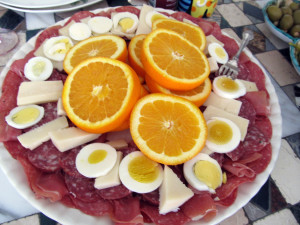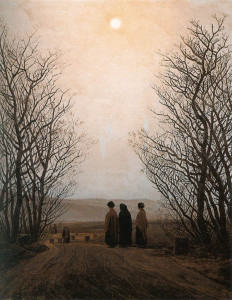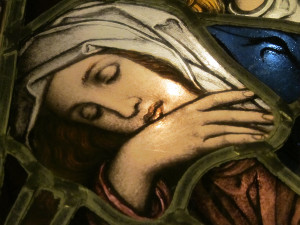Come noon on Holy Saturday, that is today, lent is over. Or so this was the tradition in my grandparents’ home. The day before was Good Friday and my mother recalls that on Good Friday, the home was in a state of mourning, as if there was a wake going on (and back then wakes took place in the home). “You couldn’t turn on the radio,” she says. “You couldn’t even step on the cracks of the sidewalk.” She doesn’t remember whose rule that was, but it was, nonetheless, a Good Friday rule for my mom as a little girl.
But by noon on Holy Saturday, the mood shifted to one of preparation for the next day’s big feast. In their home, the Easter meal was usually lamb: chunks of it braised on the stove with garlic and onion, then mixed with spring dandelion greens, scrambled egg and parsley and grated parmesan cheese. In their dialect from Lucera the dish was called spetsada (and I’m not sure of the spelling, considering this is not true Italian). The lamb and the eggs bring important symbolism to the Easter table, foods we take in that tell the story of spring’s renewal through subtle hints of sacrifice and resurrection.
At Grandma Cutrone’s table, the meal was typically a fancy pasta dish like ravioli. And this typically is what our Easter table holds, too. The ravioli are always homemade and that part of the meal is always preceded by a special Easter antipasto called la fellata. It begins with a large platter (we like abundance, so the larger the better!). First on the platter are paper thin slices of salami and prosciutto, and atop them, rounds of pepperoni and soppresata, sliced hard boiled eggs, wedges of sharp provolone and slices of fresh mozzarella. In the very center goes an Italian basket cheese, which we usually call “cheese in the basket,” but just as my grandparents all spoke their particular dialects of the Italian language, even “basket cheese” seems like a sort of Italian-American dialect. Its proper Italian name might be canestrato, but basket cheese seems its most prevalent name, and the name comes from the cheese being formed inside a basket––once reed but now most often plastic––so that the impression of the basket is apparent in the finished cheese once it is removed from the basket and placed on the table. Sometimes, if the platter is just too close to overflowing, we might place the fresh mozzarella and the basket cheese in a platter of their own. If your fellata is to be truly delicious, you’ll procure all of these items from a good Italian market, rather than from the supermarket. (When’s the last time you had good fresh mozzarella from the supermarket?)
What separates Grandma Cutrone’s version of la fellata from that of my mother’s family is the addition of sliced oranges. Perhaps they began as leftovers from Grandma Cutrone’s St. Joseph’s Day altar in March, for she always placed baskets of oranges at her altar for St. Joseph. No matter how or why, the sliced oranges brighten the platter. They are cut in thick rounds with one slice from the center out to the peel, so that the orange sections can be pulled apart into a big toothy grin. And of course colored eggs and baskets of the taralli that were the focus of the last chapter of the Book of Days. (I included a recipe for taralli there should you be looking for a good Holy Saturday project.)
Getting through the meal at the Easter table at our house takes hours. Like the Easter Vigil Mass that begins at sundown tonight, it is an occasion not for the faint of heart. It is an event for which one brings a hearty appetite for food and for life. And as we toast each other at that table so we toast you: Buona Pasqua a tutti!


